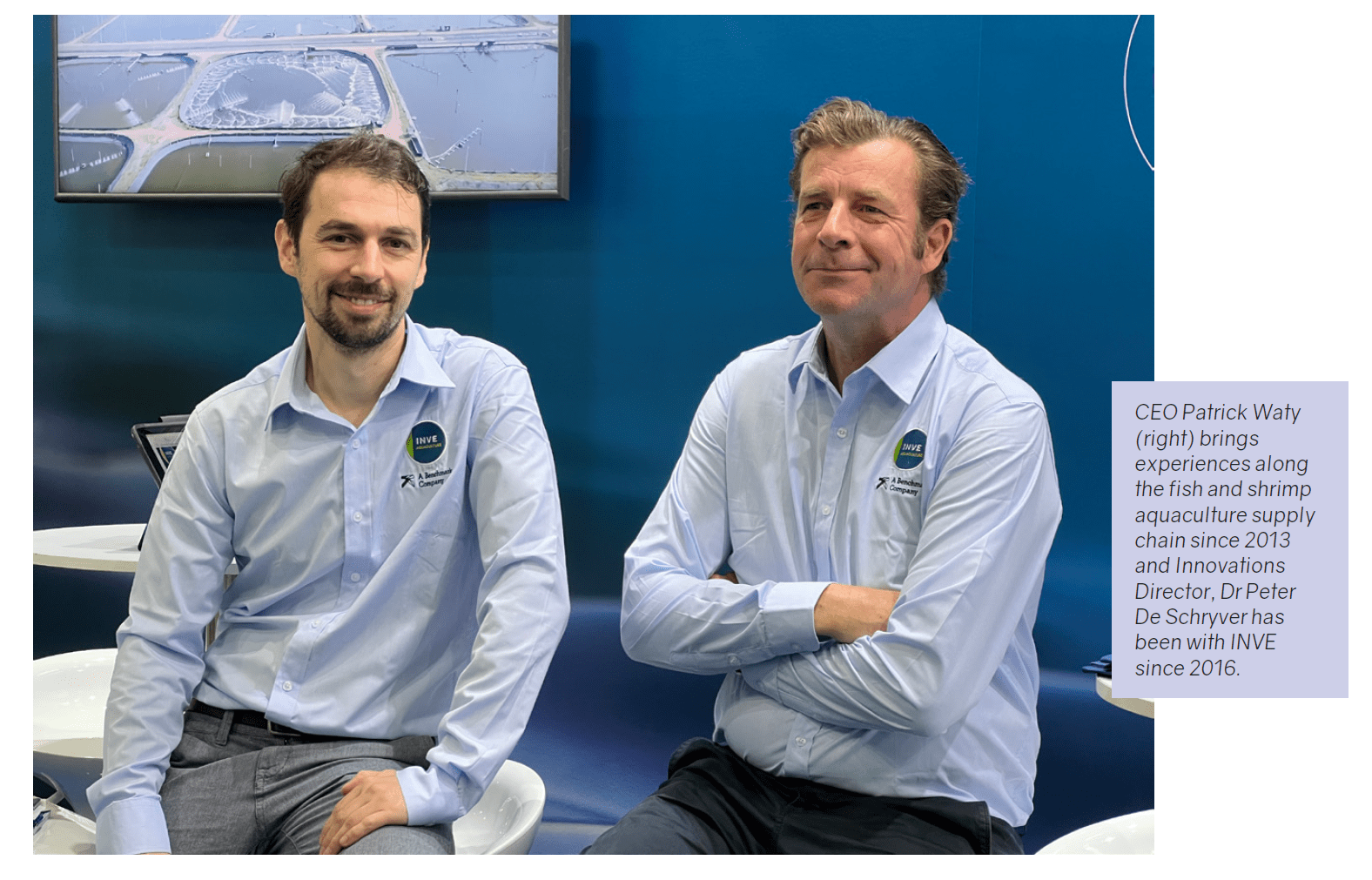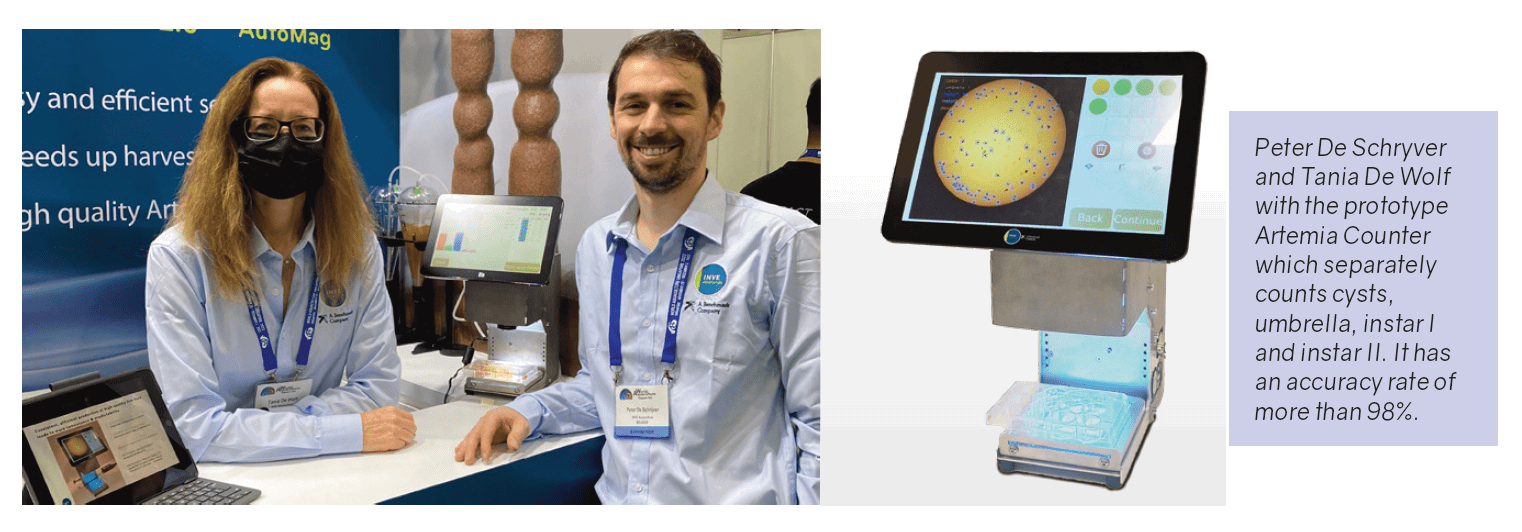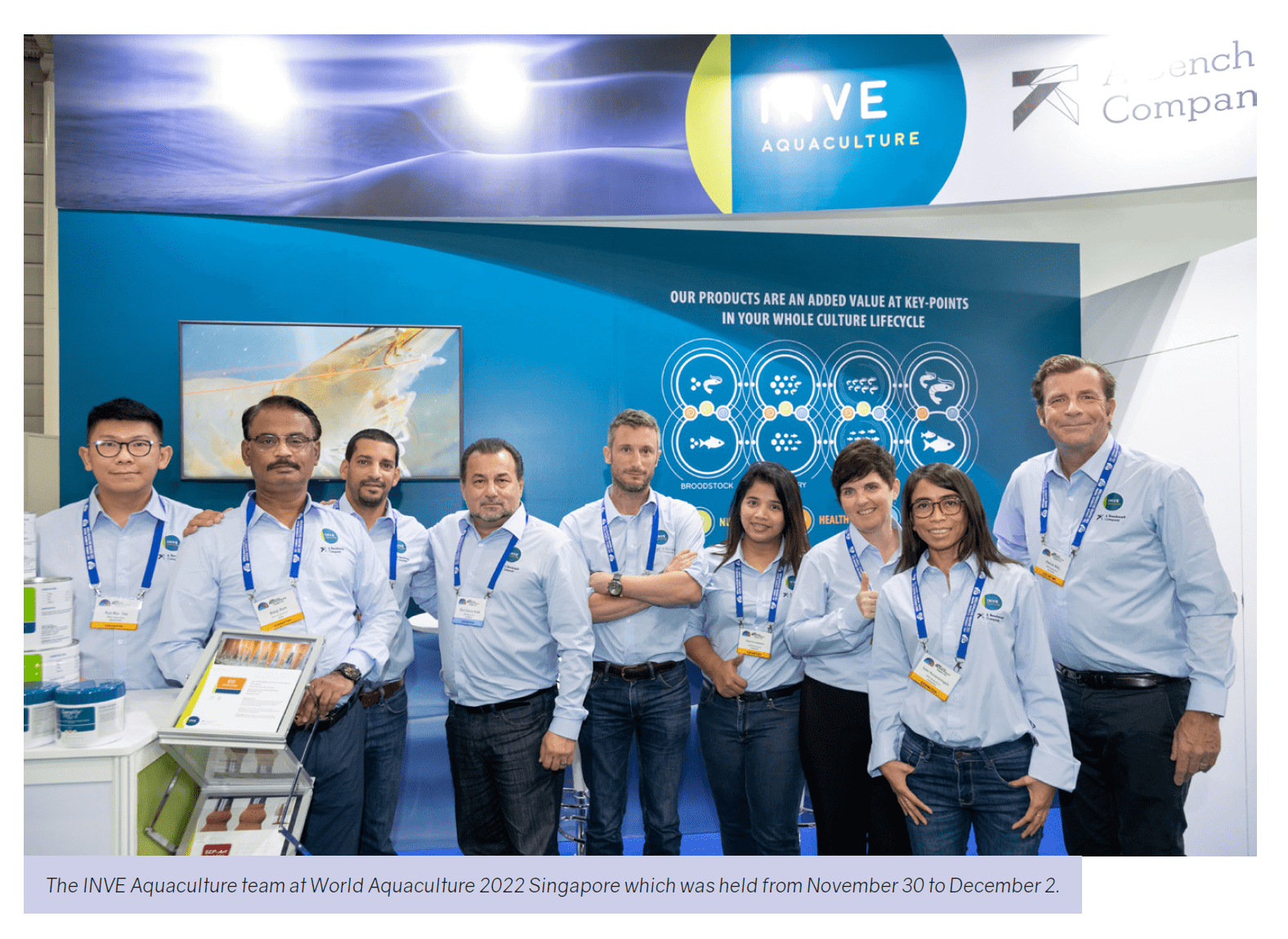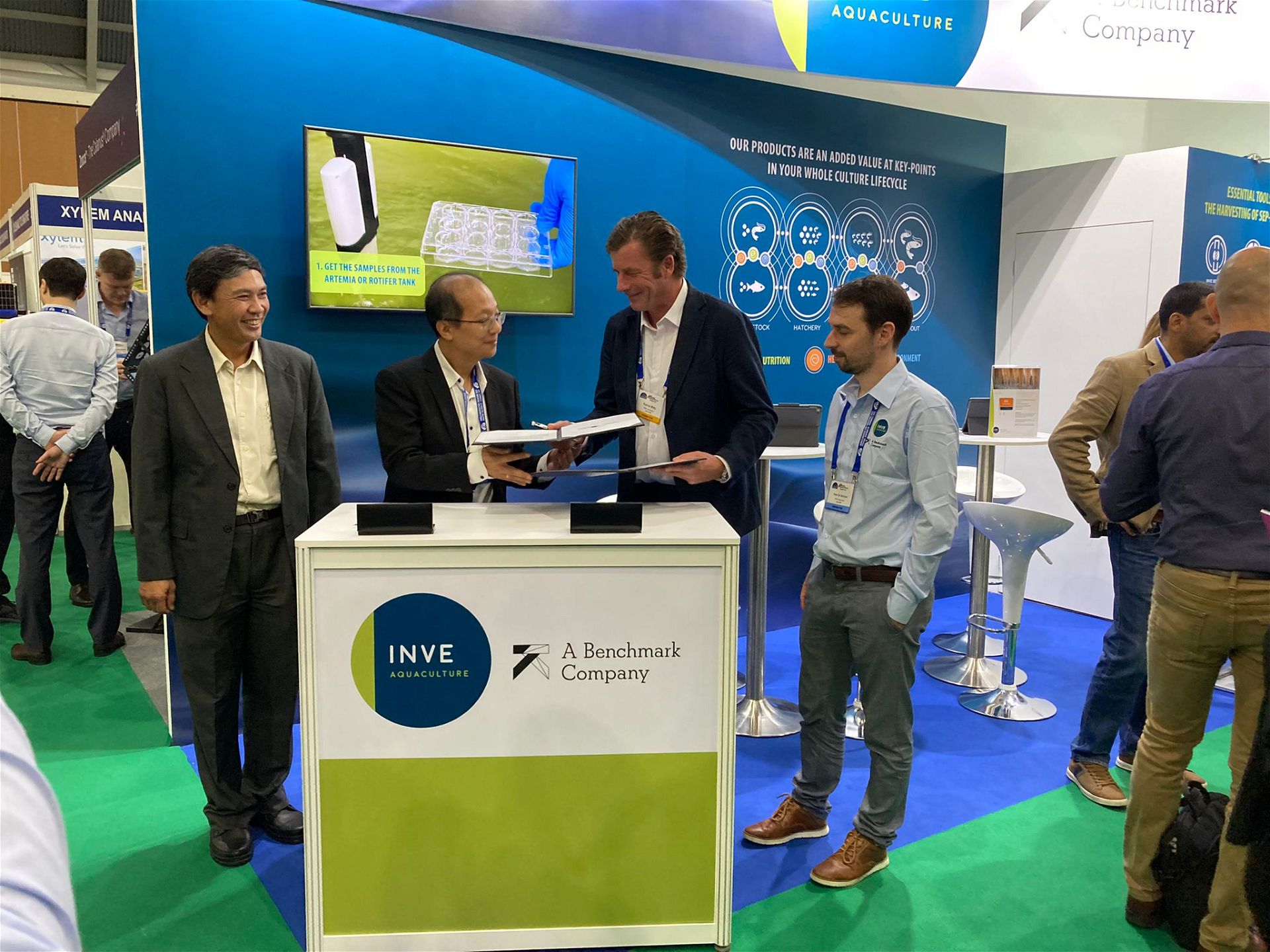Moving towards standardization and data-driven automation to de-risk industry and increase production efficiency.

Back in 1983, Artemia Systems NV, a spin-off from Ghent University, was the first to market Artemia. In 1991, it was acquired by INVE Aquaculture, which up to today, remains the market leader in the supply of Artemia cysts worldwide. INVE, part of Benchmark since 2016, is active in four areas; broodstock management to improve spawning, egg production, and larval quality; specialized hatchery care to optimize fry and post larval robustness, survival, and growth; well-balanced and cost-effective growth of fry and post-larvae in nursery, risk management, and prevention at grow-out.
During World Aquaculture 2022, Aqua Culture Asia Pacific caught up with INVE’s CEO Patrick Waty, who since 2021, leads the global team of 400+ employees. Waty joined the aquaculture world in 2013 after more than 8 years in the seafood business. His experiences range from early feeds as CEO at BernAqua; global aquafeed business development at Neovia (now ADM) and lastly as group CEO at SyAqua. Dr Peter De Schryver, who has been with INVE since 2016, joined the interview.
The competitive edge
What gives INVE the competitive edge in the shrimp and fish hatchery and nursery segments?
Patrick Waty attributed INVE’s competitive edge to the science-based knowledge behind its founding.
“We are a result of a spin-off from the University of Ghent, Belgium, more than 40 years ago. Some of the people involved were also visionaries, quick to see immediately opportunities such as in marine fish aquaculture in Europe, which was still a backyard industry back then. It needed a lot of structure.”
He added that it took 40 years to bring the marine fish industry where it is now in Europe.
“Thirty-five years ago, there were opportunities in shrimp farming in the tropics. In the early days, the focus was to bring science into precise nutrition and formulation. They looked closely at the health aspects and nutritional needs of shrimp, started taking the impact of the environment into account, started considering bioremediation for better water quality via probiotics, etc. Our next opportunity is to replicate what we have achieved with marine fish hatcheries in Europe to tropical marine fish hatcheries here in Asia.”
INVE became part of the Benchmark Group in 2016? What is the advantage of being in the group?
Within the Benchmark Group, which fully focuses on aquaculture, there are three divisions: Advanced Nutrition, Genetics and Health. Advanced Nutrition is only INVE and represents more than 60% of the group’s activities.
“Being within the Benchmark group has given INVE more visibility and more structure,” said Waty, “For us, when reaching a critical size, we will need to adapt to a more corporate structure. This gives us a wider network and we have a unique opportunity to inspire ourselves from the salmon industry, which is way ahead. It is not just copy and paste but a good source of inspiration. This is what Benchmark brings for us.”
Dr Peter De Schryver elaborated on links between the different aspects of aquaculture.
“We cannot have a successful performance only with nutrition. We also depend on the genetics that we are working with. So, when we bring everything together that is where we will be most successful. Within Benchmark there is an internal innovation board with representatives from each company working together and identifying which are the major areas of innovation. Although each of the business divisions do their own internal innovations, the innovation board is intended to support those innovations that are interesting for and require the collaboration from across the group. Dr Ross Houston is leading this innovation board.”
Sustainability at the hatchery segment
In October 2022, INVE announced that it is an associate member of SSP? How important is this initiative for the business in Ecuador?
Clearly Waty is impressed by the Sustainable Shrimp Partnership (SSP), which is an excellent initiative by Ecuador’s shrimp sector. Through SSP, its shrimp industry has made tremendous steps to market and differentiate its shrimp. It is adding value to the image and the quality of the product. It is not only shrimp with very good taste but the story behind them. This SSP was started at the farm level and has included processing plants.
“Last year, I talked to Pamela Nath, Director of SSP on more sustainable practices in hatcheries to further raise sustainability in Ecuador. I suggested our technology on the separation of Artemia cysts in a mechanical way with a magnet. This is a clean way of de-capsulation and a practice that has an impact on sustainability. “We feel we can progress with this since Ecuador wants to promote healthy shrimp coming from healthy environments. Aside from this, other INVE technologies are probiotics in bioremediation to leave a clean pond after harvests.”
In terms of nutrition, De Schryver said that they are on a lookout for sustainable ingredients in the formulations such as replacements for fishmeal, without compromising on performance.
What do you think of an initiative similar to SSP in the Asian hatchery segment?
Although his opinion is that Asia should also have this type of initiative, Waty advised that they should be supported by local organisations or governments. “It is not neutral if you are doing this on your own. So, I would rather see initiatives done together, such as in Ecuador, where different stakeholders from the industry, are addressing this matter.” He emphasised that sustainability is in the interest of everyone and is not just a “we are green” labelling. Initiatives should have the support of certifications such as the GLOBAL G.A.P., ASC, Friends of the Sea etc.
“Today, these addressed the segment with the biggest impact, which is farming. We should not forget that hatcheries and early stage is the pillar of success for good farming practice and therefore, this segment will be the next line of initiatives.”
Markets
Among the countries in Asia, where do you have a strong presence or see a potential for expansion?
Waty’s quick reply is the hatchery segment in India, where it has an excellent distributor.
“We also want to be closer to customers. We have a new team in place that will introduce the Artemia SEP-Art technology in India. There will be new diets for the Indian market, such as nutritional flakes and boosting flakes. We feel that these solutions are required in India, which is facing some challenges and I expect these initiatives to help India ride the storm.”
What have been your game changers for Asia?
There is the decapsulation technology, Artemia SEP-Art introduced in 2009. The team noted that INVE is investing more into an approach of more efficient production of live food.
“For us, it is not just products, but protocols and standing close with our customers in getting them to be more efficient. Our technical support part of the company is so important for us,” said Waty.
At this World Aquaculture 2022, the company presented a prototype of a new device for more automated counting of Artemia and rotifers, which will increase the efficiency of hatcheries with less labor, higher accuracy and improved protocols. De Schryver explained
“This automated counter gives the possibility to evaluate the status of Artemia cyst hatching very quickly, with an accuracy of more than 98%. It will allow hatcheries to have more control over cyst hatching. In a matter of seconds, our counter can determine the number of cysts, umbrella, instar I and instar II stages. It will be an interesting tool for them to make sure that they can get the highest quality out of the products that we are offering them. For the hatchery, the value here is that instar I has a much higher nutritional value than instar II. So, if a hatchery technician is using instar II, it is a lower quality product, but it has the same cost.”
Waty added,
“Achieving more precision farming and feeding and bringing more standardization into our industry will be a game changer. We do not need to be rigid, but we need to have more standards in what we are doing. This starts with standardization in water quality (pH, temperature, nitrate etc.) as it is the environment where our animals are living. We need to set norms for each species, culture system etc. For the moment, we are still going the empirical way.”
Is there a particular region or segment which has been particularly challenging?
“We are geographically well spread and therefore, no market is particularly more challenging than another. For me, the most difficult segment to address is tropical marine fish species. This is because this industry is not as structured as that in Europe yet. It makes it more challenging to know where to start and to whom we should speak to make changes” said Waty.
In your opinion, what should the shrimp industry in Asia focus on?
This is overall efficiency, said De Schryver,
“We need to have a higher degree of standardization, knowing what we are doing. Now it is very fragmented with different practices from region to region. But we need to collaborate as an industry; the farmers, producers and suppliers need to make that connection and work together. We should not just use products and see how it works and do it in an empirical way but collaborating really towards a more knowledge basis.”
Waty believes in convenience, automation and standardization.
“Sometimes, by standardizing protocols, you will make the life of the hatchery technicians much easier. Now, protocols are still too complicated. When we have innovations towards the direction of convenience as well, it will be easy to use and easy to replicate.” De Schryver echoed, “Today, we should focus on what we have and improve on them. We cannot just rely on the creation of silver bullet solutions for problems such early mortality syndrome (EMS) and Enterocytozoon hepatopenaei (EHP) when we think of diseases. We need to work at other levels at the same time.”
From a welfare point of view, there is a lot of interest by consumers and others in the industry with regards to broodstock ablation. The whole genetic program with Benchmark is based on non-ablated females. Therefore, within Benchmark, the Genetics and Nutrition groups need to collaborate to see the effects of moving away from ablation. “There is a need to further study how this non-ablated approach can be further optimised, for example through improved nutrition, to provide even better quality products to the farmers,” said De Schryver.
What are the changes needed for a better hatchery and nursery segment?
Over the next 5 years, the list is standardisation on water quality, automation, convenience and focus on de-risking the industry. Waty reiterated on his dream on standardisation, that the water discharged from tanks is as clean as it went in.
“We want to bring those standards, to bring this transfer of knowledge and to help this tropical marine fish to grow. We need more automation and convenience. The latter is the convenience of SOPs and having products close to the hatcheries.”
There is a need to find ways to de-risk the high-risk hatchery segment.
“As much as possible, we need to remove all the risk factors by adopting some protocols.” said Waty. “With regards to broodstock, I question the practice by the hatcheries and the governments favoring specific pathogen free (SPF) broodstock. As I see it, in shrimp hatcheries, at the very first moment the SPF broodstock is in a hatchery, it loses its status of SPF because of feeding with squids, polychaetes and sandworms.”
When nurseries are added, it is increasing the efficiency with more robust animals and ensuring more cycles in the farm. INVE encourages this practice and has excellent solutions. De Schryver explained,
“Our raceway solutions are a combination of optimal and booster diets to make shrimp stronger at specific periods such as at the point of transferring from one stage to another. There are probiotics to keep optimal water quality, digestion of waste and contribute to feed assimilation. For us, the combination of all of the above is most important.”
The target of automation is enhanced efficiency of live food production. De Schryver strives for automation at the production level in the tanks to increase efficiency in hatcheries. Knowing the biomass of live food and the requirement of the fry or larvae, is an efficient way to avoid overfeeding and underfeeding. The purpose is also to maintain optimal water quality.
“At INVE, the driver is our customers’ efficiency. We are customer-centric and if our customer is successful, it means that we will also be successful,” concluded Waty.

Working with marine fish hatchery technology in Singapore
On November 30, Singapore Food Agency (SFA) and INVE Aquaculture signed an MOU to jointly set up a SFA-INVE Hatchery Technology Centre at SFA’s Marine Aquaculture Centre (MAC) on St John’s Island. The proposed centre will bring together SFA’s expertise in hatchery design and production for tropical marine species (e.g., Asian seabass Lates calcarifer and red snapper Lutjanus spp), as well as INVE’s in-depth knowledge on specialized fish nutrition for early developmental stages, including its patented technologies for live feed.
Waty elaborated on the origins of this MOU.
“Over the the pandemic years, we were able to build an outstanding network together with SFA. The facilities at MAC opened my eyes. So, I said to myself that this is a real opportunity for a company which is ready to transfer knowledge. In the first month after joining INVE in 2021, I was already addressing this matter with Peter, who oversees R&D and Innovation. We decided that we must open ourselves to Singapore and the region; open our books and our knowledge, transfer this knowledge because if we keep the science just for us, it will not work.”
The advantage at MAC is the excellent facilities, well maintained with different systems from a hatchery until grow out and a live feed section, culturing rotifers, Artemia and microalgae. A unique opportunity is the excellent knowledge of Asian seabass as well as for other marine species. Some breakthroughs are on the way by adapting its protocols and products to tropical fish species. This will increase efficiency, survival rates and reduce deformities.

“We are using the knowledge that we have on the Mediterranean fish species and we are going to transfer this knowledge to some tropical fish species. It is not only to improve on our knowledge but to create more synergy. It is not just with our local interactions but for the region. Singapore has its ‘30 by 30’ goal but also wants to be a reference point for the region. This is also an ambition of INVE,”
Said De Schryver. The MOU includes the setting of a hatchery centre to demonstrate the latest technologies as well as specific hands-on training. This will be conducted by INVE’s technical support team.
“This is where I think we can play a role by opening these doors because we have the customer base. If we want those customers to be more efficient and follow new protocols and new practices, we want them to visit these facilities,” said Waty. “In the future, we will identify joint research projects, on topics of benefit for all -SFA, INVE and for the region,” said De Schryver. “We believe in collaboration; we are also open to collaborate with others from the industry. We believe that when we all work together, we can benefit the industry. We truly want also to use this initiative to broaden our network and to broaden our collaborations overall.”
Waty justified,
“We need to recognize marine fish species here are not the same as those in Europe. Therefore, we must do this R&D innovation very close to the market.”
This article was published in AquaCulture Asia Pacific Magazine.